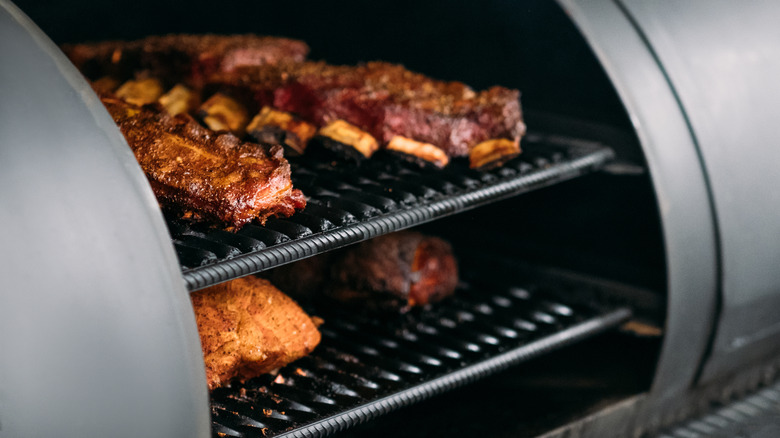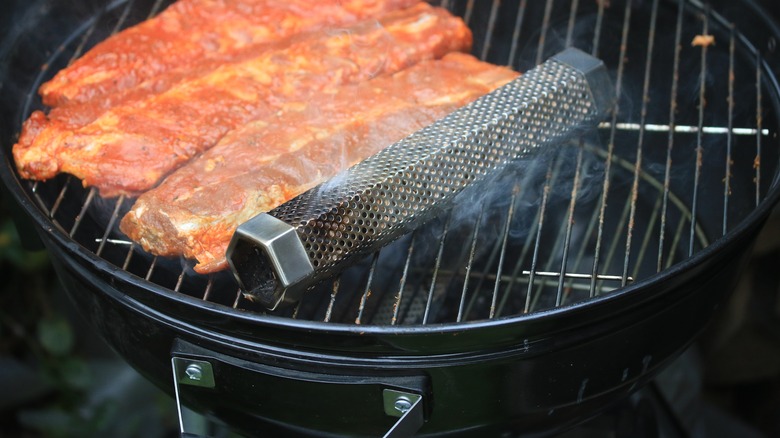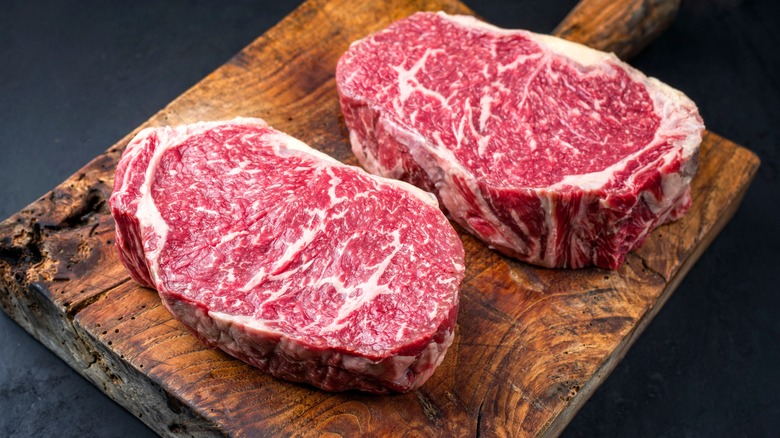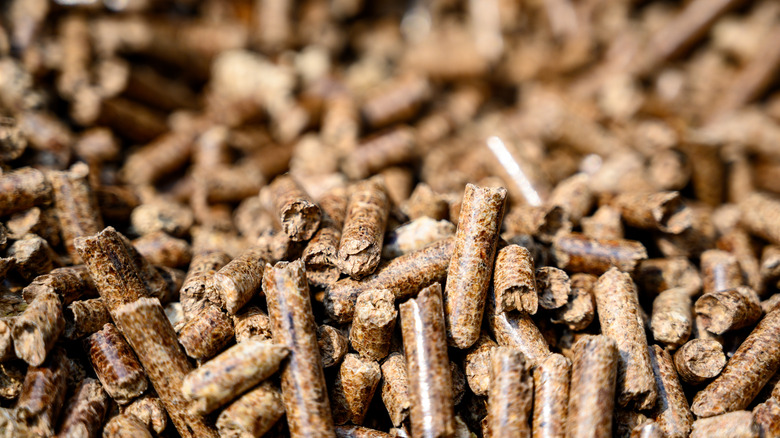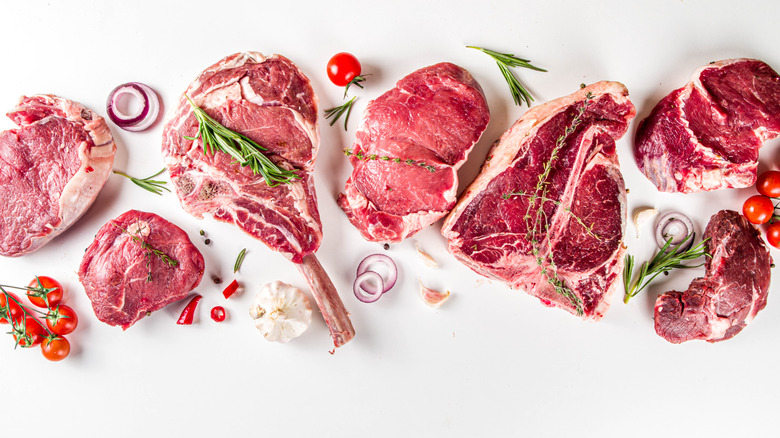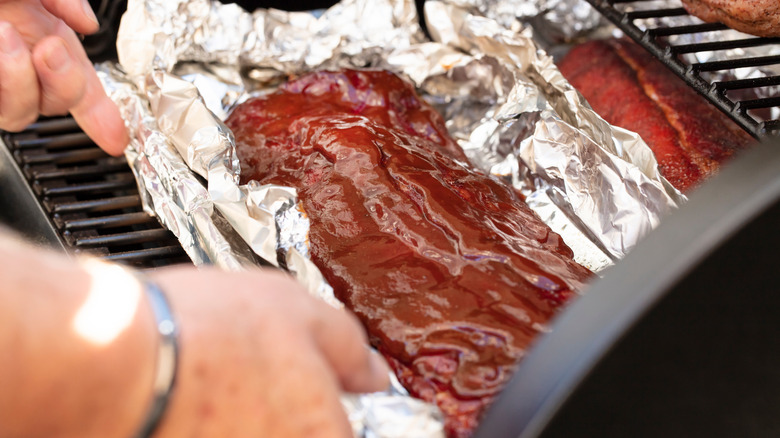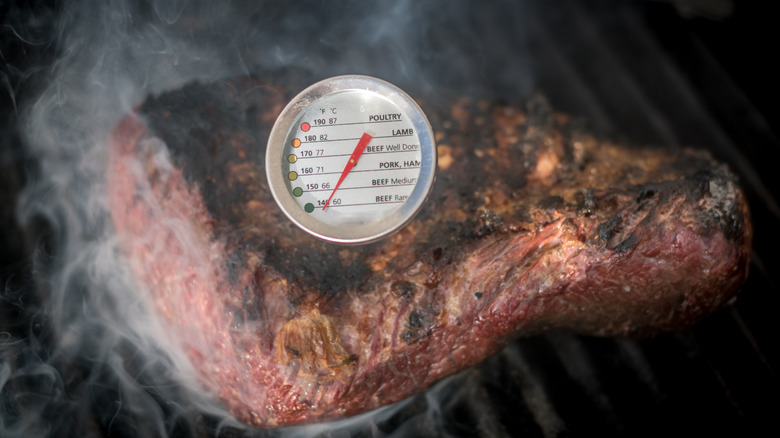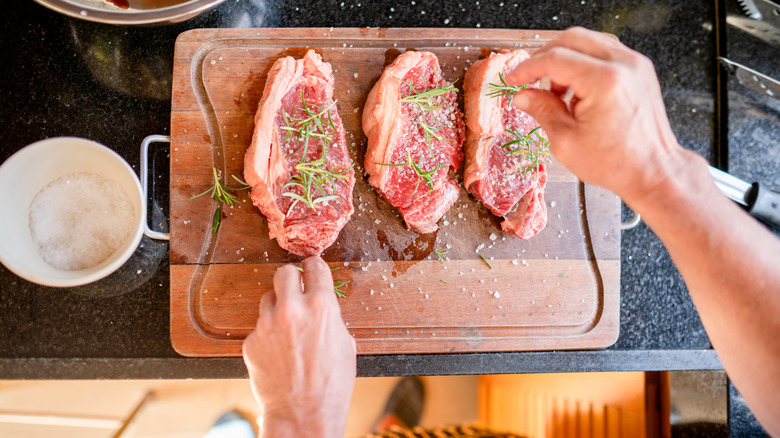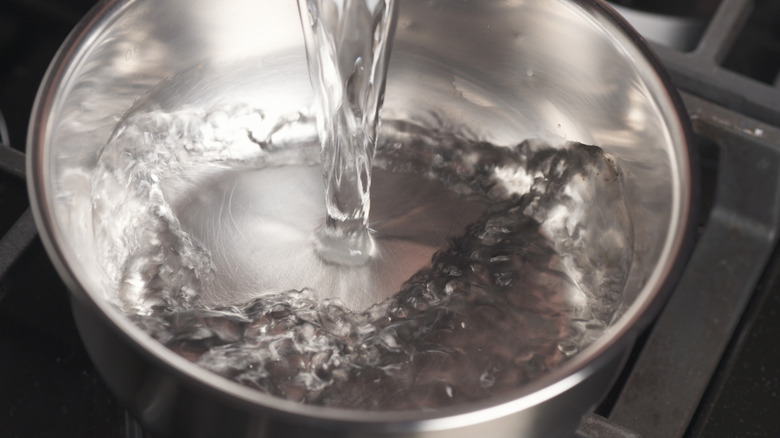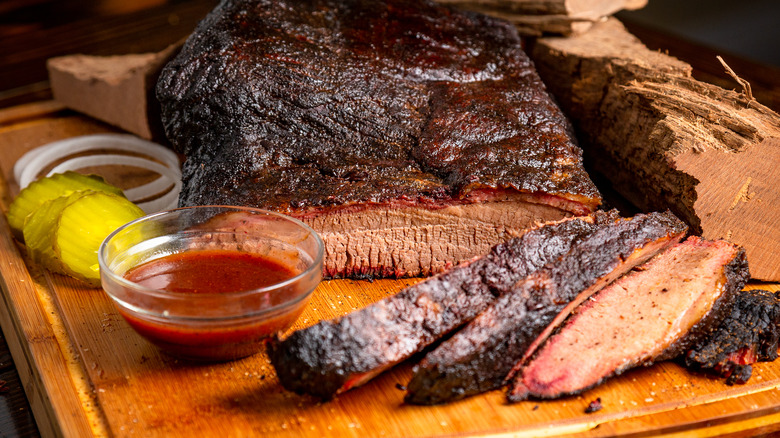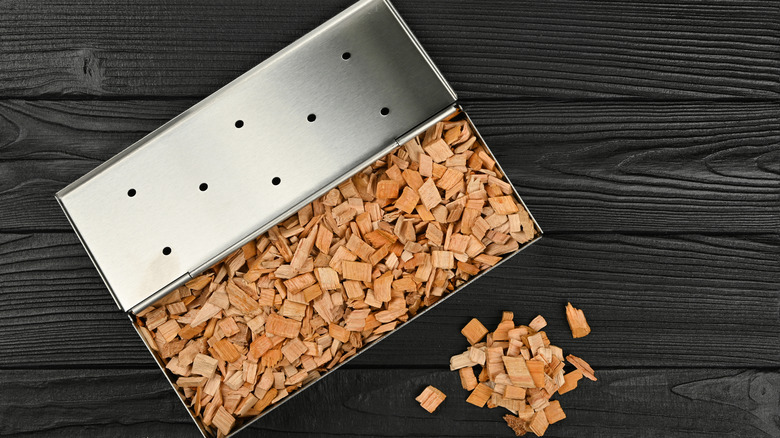11 Meat Smoking Hacks You Need To Try This Summer
Those steamy summer months are officially here, and there's truly no better time to prepare, savor, and share some mouth-watering, slow-cooked meat in the comfort of your backyard. Whether you're an experienced chef or an enthusiastic home cook, there are always new techniques to try when it comes to smoking meat. From flavorful seasoning tips to different wood types, these tips can limit some of the challenges in your barbecue game. With them, your next cookout is bound to impress.
Choosing the best meat, smoker, and materials will go a long way. However, it's not necessary to invest in overpriced gadgets and complicated machines. Implementing a few of these easy tricks will help you cook well-seasoned, juicy smoked meat without breaking the bank or teaching yourself complicated cooking lessons.
Smoked meat is more than a tasty treat, it has health benefits that might surprise you. The next thing you know, you're adding brisket and more to your shopping list. Smoking meat slowly and at the right temperature kills certain bacteria, preventing your meat from spoiling, according to the company Napoleon. Additionally, as CureJoy explains, pork, lamb, beef, and venison are all great sources of iron. This can be great for supporting a strong immune system, per a study. If you're not yet convinced, the delectable savory aroma of your first batch of smoked meat will have you jumping on the bandwagon.
1. Use a smoke tube
If you don't have a superior smoker that uses wood or charcoal, or you want to ensure that extra smoky flavor, consider using a smoke tube to achieve that rich taste when smoking meat. A smoke tube is a device that can be placed inside your grill. It's typically a foot-long pipe that has holes along the sides.
This affordable, easy-to-use tool is filled with pellets or wood chips. Next, the whole thing is lit. The smoke is condensed in the pipe and streams out of the holes, allowing your meat to absorb the smoky flavor. Be sure to place the tube somewhere on your grill where it's not in danger of falling over. Many smokers or pitmasters choose to use a smoke tube when they are utilizing their grill as a smoker, which isn't always specifically designed to capture smoke.
Using this simple tool in your smoking process can increase the delectable smoke flavor in most meats. This will help you achieve the perfect smoked Texas BBQ brisket or chicken and smoked sausage gumbo for your next barbecue. The great thing about this tool is that it is versatile enough to use with different types of meat, as well as different types of wood. You can put everything from oak wood to maple wood into your smoke tube.
2. Choose the meat with the most marbling
Marbling is fat, called intramuscular fat, that's found in meat. The white or light pink streaks that often appear in certain cuts of beef, venison, and pork roasts are called marbling because of their marbled-looking appearance. This type of fat naturally occurs on the inside of fiber muscles in animals and it can affect the flavor and texture of meat, helping to enhance taste and provide a moist texture. However, not all fat is considered marbling or good for flavor. On the other side of things, intermuscular fat, which is found between the muscles, should be stripped away. It will not cook down or increase flavor, but rather become chewy and tough.
You'll want to make sure the meat you're going to smoke has good marbling. These trace amounts of fat will essentially melt when they reach a certain temperature. Smoking meat naturally dries out the meat, which means you'll want to encourage moisture whenever possible. This is where marbling comes in handy.
The marbling melts and infuses the meat with moisture, as well as flavor. One example of well-marbled meat is Wagyu beef, which must meet certain standards of marbling to carry this name. These specific cattle are actually given a special diet throughout their lives in order to achieve high-quality marbling. For the ultimate taste and texture, buy well-marbled meats for your next meat-smoking session.
3. Try a pellet smoker
A pellet smoker is a smoker that requires pellets, rather than real wood logs. The pellets are small, compact bits of wood, or other materials, that burn the same as wood. However, pellets are often considered easier to use and store. Instead of chopping up a log for wood pieces by hand, you can simply purchase a bag of pre-made pellets. Forget bulky logs — whether you're cutting them yourself or hauling them from the store — they are a pain. After burning, the pellets burn down into ash, which can easily be tossed or used for other purposes.
Pellet smoker options can be significantly less expensive when compared to some other tools. While obtaining a pellet smoker might demand a higher price at first, the fuel is ultimately cheaper and will help you save. If you really want to save money and achieve that smoky flavor, consider buying the pellets in bulk.
Additionally, flavoring your smoked meat has never been easier with a pellet smoker. Purchase small batches of flavored pellets. Of course, you can look to companies like Kingsford for the traditional types of wood, such as hickory, oak, maple, and more. However, the company also offers basil, sage, cumin, chili, and thyme-flavored pellets. For your next barbecue, try Kingsford's Bourbon BBQ Pellets, and then mix up a plum bourbon BBQ sauce for a truly unforgettable meal.
4. Bring the meat to room temperature first
If you want to take your cooking skills to another level, bring your meat to room temperature before you get down to the actual smoking. Thawing meat isn't always an exact science. The challenge is bringing the whole piece to an even temperature. If a piece of meat is still cold in the center, or on the bottom where it sits on a plate, and it then comes into contact with heat, the exterior could be overcooked while the inside remains undercooked or uneven. Defrost the meat thoroughly prior to cooking, then allow it to come to room temperature. This will ensure that the entire cut cooks at the same rate.
Bringing meat to room temperature safely can also improve the flavor of the meat, in addition to the texture. Cold meat that meets a hot pan can affect the way the juices react with each other and dry the meat out. This method can also reduce any aromas that might've been absorbed while in the refrigerator. Raw meat can easily take in smells that will come through in the overall flavor of the finished product. Bring your meat safely to room temperature to showcase your careful attention to detail and expert skills.
To safely bring meat to room temperature and avoid the growth of bacteria, don't allow the meat to get warmer than about 72 degrees Fahrenheit. Test the internal temperature with a thermometer prior to cooking.
5. Choose the right wood for the different types of meat
Smoking meat is a long slow process, which means the meat is exposed to the smoke for several hours. This allows the meat to not only absorb a general smoky flavor but also the particular complexities in the wood — similar to aging liquor in wooden barrels.
If you want to get all you can out of this process, you need to be particular about what type of wood you're selecting. The wood you use largely depends on personal preference. However, various types of meat are better at absorbing certain flavors and aromas. Additionally, certain meats might require extra flavor.
A few of the most frequently used woods include apple, hickory, mesquite, cherry, and oak. Hickory will give your meat a powerful, bold flavor that works well with marbled beef and cuts of pork. Mesquite wood has a more distinct, nearly bitter taste that will elevate beef. Apple and cherry woods are classic and commonly used because of the muted, agreeable flavor that can be excellent for poultry and even fish. The mild and more subtle flavor that comes from oak makes it a favorite go-to for almost all types of meat. Apple, cherry, and oak wood can be found by most home chefs at their local supermarkets.
6. Wrap the meat during the final cooking stages
Another meat-smoking trick is wrapping it in aluminum foil or butcher paper in the final stages. This game-changing trick works best at the end because it allows the meat to crisp up early on, then cook evenly and quickly once the perfect bark is achieved. As the meat will still need time to cook, wrapping it will prevent that crunchy exterior from getting too crispy or burnt. Wrapping the meat also helps to trap moisture. The steam that's released under the cover circles back to the meat. Your final result will be tender, juicy, and perfectly cooked. This is an honored trick, but the timing needs to be just right.
For brisket, it's best to wrap it in foil after a few hours of smoking, depending on how large the cut is when it has reached approximately 160-170 degrees Fahrenheit. At this time, you can be sure that the heat from slowly smoking has broken down some of the collagen, resulting in a tender brisket with a scrumptious bark. In comparison, try wrapping pork shoulder in butcher paper, it's more breathable and could result in a more crispy bark.
For ribs, it's a bit more complicated. Try smoking ribs until the bark is crispy, then wrap them in foil. Allow the steam to trap the moisture, and create extra juicy ribs. Finally, remove the foil for the last bit of cooking to get a crisp exterior that will melt in your mouth.
7. Use two thermometers
Any smoker with a little experience will tell you that one way to really hack perfectly cooked meat is to use not one but two thermometers during the smoking process: both a leave-in and a digital instant-read thermometer. You can get by with one, of course. But it's the extra step of double-checking that will help you achieve professional-level barbecue.
The leave-in thermometer is your go-to. This will allow you to check on the temperature consistently and quickly throughout the smoking process. You don't want to be opening your smoker or grill too frequently while cooking, allowing all the heat and smoke to escape. Stick a leave-in thermometer where it's not in danger of falling out and somewhere where you can easily and quickly check it.
Compared to a leave-in thermometer, the digital instant read is also great to have on hand. Use this tool to quickly and accurately determine the temperature when you think the meat is nearly finished cooking. This handy tool can allow you to test the temperature in various places to ensure the meat is fully cooked throughout. In just a few seconds, you can double-check that the leave-in thermometer didn't malfunction or give you a false reading. Having both tools will set you apart from other pitmasters. Quality cuts of beef and other meat are expensive and the last thing you want is to spend all that money and take all that time, only to over or undercook your meat.
8. Always include some salt in your seasoning and rubs
Salt might sound like a no-brainer, but not every recipe calls for it. However, adding salt is a hack you do not want to skip when smoking meat. This single spice will help create that extra flavorful and tender piece of meat, by drawing out meat's natural flavor. Be sure to add salt to your marinade, rub, or simply begin by tenderizing the meat with salt.
Applying salt to raw meat will immediately begin drawing out moisture. From there, the salt begins to dissolve, creating a brine of its own. Throughout the smoking process, the meat will reabsorb this drawn-out moisture, adding more flavor. This helps to create a slab of juicy and flavor-packed meat. Salt also breaks down the proteins and fibers of the meat, making the meat more tender.
Another hack is to use table salt if you're applying it to a marinade or a dry brine. The extremely fine crystals will dissolve easier in small amounts of moisture. If you're going for a dry barbecue rub and want a more powerful punch of flavor with some texture, consider using a coarser Kosher salt. These larger pieces work better in this application.
9. Use a bowl of water to keep the meat extra juicy
One of the biggest challenges when it comes to smoking meat is having the patience to cook it correctly, while also maintaining that desirable juicy, tender piece of meat that melts in your mouth. A sure sign of an inexperienced grillmaster is an overcooked, dried-out piece of meat. How do you avoid this common pitfall? Try placing a bowl of water in your smoker or grill while the meat is smoking. As the water heats, the resulting steam will create a humid cooking environment that will keep the meat from drying out into a piece of chewy leather. A water pan will also help maintain a stable temperature while cooking, by either radiating or absorbing heat if the temperature fluctuates.
Certain smokers already come equipped with a water pan. However, if you're using a makeshift pan, remember a few tips. Use a high-heat-safe bowl. Do not use a bowl made of plastic or wood. Placing the water below the meat is the best option, but if there isn't space, your next best placement is somewhere that is not directly over the heat source.
This trick is especially important when preparing leaner cuts of meat that won't have as much natural moisture — such as chicken breasts or pork tenderloin. For even more added flavor, try filling the water pan with apple juice, beer, or broth. As the steam evaporates, it will infuse with the meat.
10. Use a spice rub to get a crispy, crunchy bark
Truly mouthwatering smoked meat has something that sets it apart from others: the bark. The bark is that delectable, crispy exterior that forms on the outer layer of meat when it's cooked long and slow. Loaded with flavor, this crunchy exterior is the perfect contrast to the moist, tender meat under the surface and it's the mark of an experienced smoker. This extra detail can sometimes be hard to achieve, but a spice rub will have you starting off on the right foot.
A dry rub is typically a combination of spices, herbs, and sugar that is generously applied to the meat prior to smoking. The spices stick to the damp surface of the meat, helping to form the bark. As the surface of the meat begins to dry out, the spices (which often have a bit of texture) combine with this layer. Because the spices are exposed to the heat first, they crisp and caramelize with the top layer of the meat, which seals in the flavor and juices.
During the cooking process, your bark will continue to take the brunt of the heat. This is why — once a solid bark forms — you may want to wrap or cover the meat to protect it from the intensity of the heat and avoid over-crisping. Although marinades can create somewhat of a bark, a dry rub is the best way to achieve that crispy crunch.
11. Use a stainless steel smoker box instead of cast iron
A smoker box works in a similar fashion as a smoker tube. The pitmaster adds wood or charcoal to the box, then places it in the smoker for a concentrated smokier flavor. This also helps prevent the wood from getting too charred and ruining the flavor. However, a box (versus a tube) will more evenly distribute the smoke. It can also handle bigger pieces of meat and larger smokers. If you're a serious smoker and want to invest in a quality smoker box, then the most popular options are stainless steel and cast iron. Our advice is to opt for stainless steel.
A cast iron smoker is bound to be durable and very efficient. However, the clunky, heavy material is prone to rusting over time and is just heavy. This is not only difficult to clean, but can even end up giving your meat a metallic taste. Stainless steel versions may be slightly more expensive, but they aren't as heavy and aren't likely to rust. Simply wash them with soap and water for easy cleanup and still achieve that smoky, delicious flavor.
